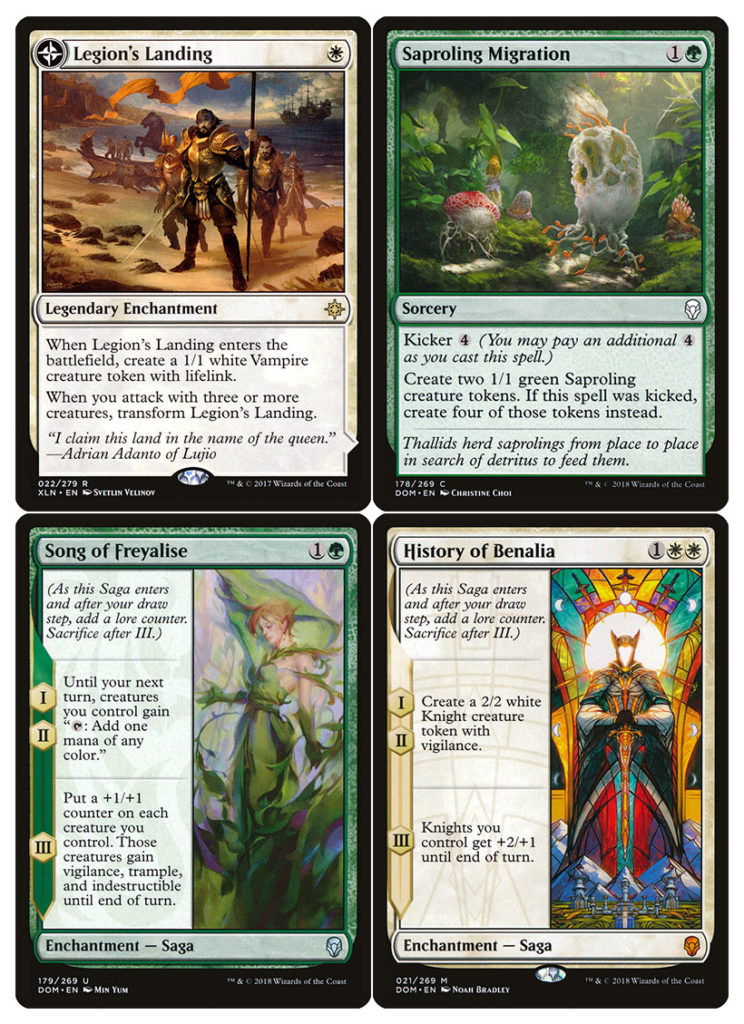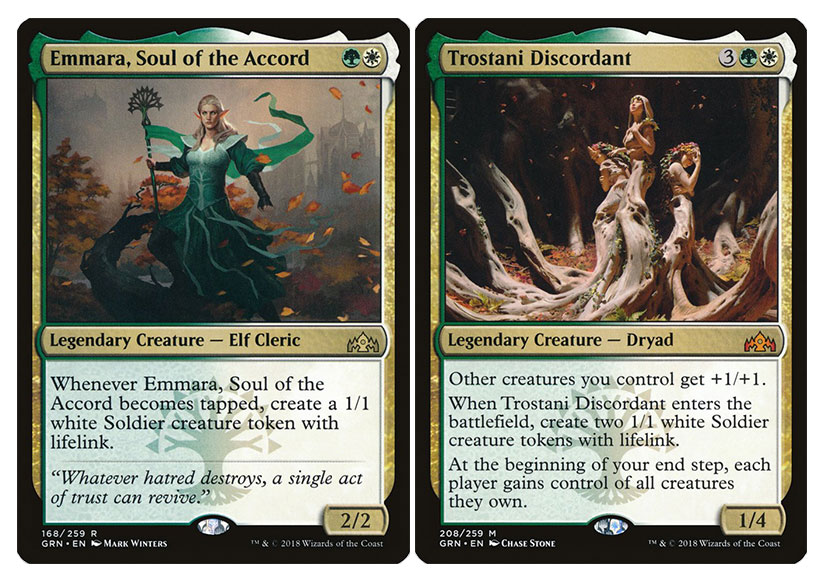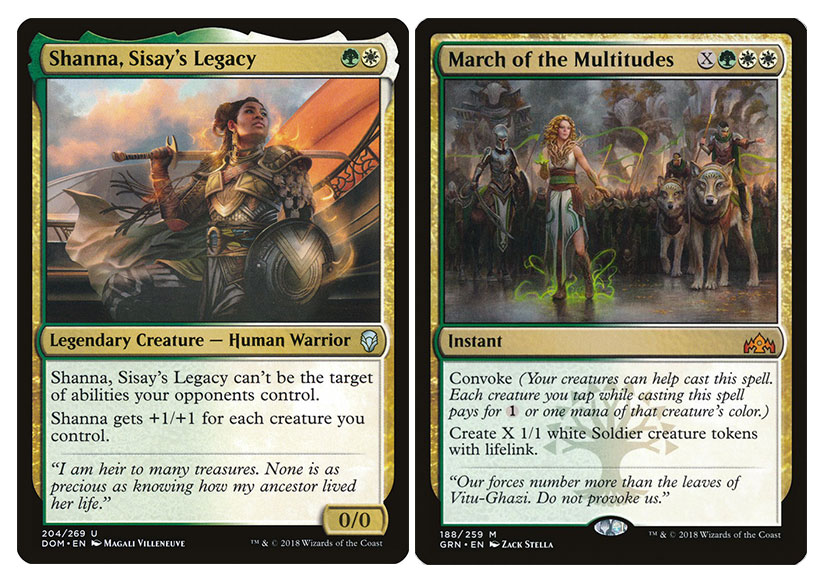By Nick Prince
Last weekend, I won a PPTQ in San Fernando. The deck I chose was my own take on GW Tokens built around a card the community at large is sleeping on: Song of Freyalise. No longer just a wrecker of Dominaria Limited games, Song is the tool that puts tokens decks over the top in this new Standard. Plus, there was a sharp decline in the number of Goblin Chainwhirlers running around. That caused many lists to be flat footed against Song, losing tempo to its mana advantage before Chapter 3 overruns them.
The tournament wasn’t large, but it was full of stock decks from what I saw: Mono-Red, Green Black, Green White, a couple Teferi, a Mono-Blue player, etc. Outside of the Top 8 when I played against a RB Sword-Point Diplomacy/Risk Factor deck, they were all decks I’d seen in the MTGO decklist dumps or in recent large tournaments.
GW Song of Freyalise
Song of Freyalise and pretty much any combination of cards in the list under four mana creates a very short game for opponents. Once March of the Multitudes was spoiled, I spent a lot of time theory-crafting various combinations of cards that worked well as part of a sequence with Song. My proof of concept that kept me watching for ways to abuse it was the combination of Emmara, Soul of the Accord, Song of Freyalise, Shanna, Sisay’s Legacy and March of the Multitudes, which alone is lethal on Turn five (assuming no missed land drops). Trostani Discordant and Venerated Loxodon gave the deck a number of other ways to create a board state opponents can’t beat when Song hits Chapter 3.
The Gameplan
A few examples:

Turn one Legion’s Landing, turn two Saproling Migration, turn three Song of Freyalise plus History of Benalia does 16 damage. Literally anything that adds two creatures or three or more power is lethal.

Turn two Emmara, Soul of the Accord leads into turn three Song of Freyalise plus any one or two drop (even a second Emmara). Follow that with Venerated Loxodon or Trostani Discordant, and you get close to or sufficiently lethal damage on turn five.

Curving Shanna, Sisay’s Legacy, into Song of Freyalise plus Saproling Migration, and then turn four March of the Multitudes (X=4) does exactly twenty damage. Admittedly, just about anything that involves March of the Multitudes before Chapter 3 hits effectively ends the game. It’s hard to come back from attacks so big, so early.
Squeezing in an attack to flip Legion’s Landing on turn three after Saproling Migration also puts the deck up one land, so Song plus a two drop becomes possible.
Most of the scenarios above leave some amount of wiggle room on mana to deploy cards like Conclave Tribunal or add another two drop to the board. Assuming the opponent isn’t a goldfish, there’s room to still attack for lethal through some interaction, or sneak in attacks for one or two early. Any starting hand that includes Song of Freyalise and two drops is probably a snap keep. Keep in mind for sequencing purposes that Saproling Migration is the only two drop that adds two bodies to use as mana dorks on turn three, but is also the only one that can be played kicked on turn four.
When the deck doesn’t have Song, it then plays a traditional GW Tokens game just fine. Thorn Lieutenant is better in a vacuum than Shanna, Sisay’s Legacy. But in a stalled board the semi-hexproof two drop is often effectively the Abyss, which Thorn Lieutenant never really gets to be. Song is a poor topdeck on an empty board; but when both players are staring at each other, a Song of Freyalise forces opponents to win or make bad attacks to trade off creatures.
March of the Multitudes is easily the best card in the deck and it isn’t close. Lifelink-Soldier Fireball is the answer to essentially everything but counterspells, and even then its effective in baiting counter magic out so that a key threat can be resolved the next turn. It also combines well with the expensive side of Flower // Flourish—March of the Multitudes on end step, untap, Flourish is a common way to finish the game.
This deck’s biggest weakness is control: a little countermagic or a sweeper to break up the synergies is enough to keep Tokens from pressuring Teferi in game one. Jeskai with this version is just a nightmare, as they have reasonable answers to everything the deck does. Deafening Clarion clears the board both earlier and more consistently than the Esper and UW builds do. If you’re expecting 25% of the metagame to be on Teferi, I’d recommend switching to another archetype, or at least a build less naturally weak to them.
Sideboard Guide
The sideboard is what it is in large part to thanks to the work Dylan Hand put in on his version of GW Tokens. Against control, the deck can get very grindy with Dawn of Hope/Vivien Reid/Karn, Scion of Urza to mitigate the effectiveness of sweepers. In the mirror or against GB midrange, setting up Karn behind a mass of tokens or after Settle the Wreckage attacks opponents on an angle they aren’t really prepared for.
Going forward, I know I’m cutting a Lyra Dawnbringer. Three is largely unnecessary, as Mono-Red is well prepared for her. I wouldn’t go below two, as Shalai, Voice of Plenty plus Lyra is an obviously potent combo that the deck wants access to, and she sometimes comes in against GB opponents; but she’s never an all star. I’m unsure what to replace her with—Sorcerous Spyglass, Crushing Canopy, and Knight of Autumn are all possibilities for the fifteenth sideboard slot.
For specific match-ups, this is how I’ve been sideboarding with the current list:
Mono-Red
On the Draw: -1 Shanna, Sisay’s Legacy, -3 Song of Freyalise, -2 Trostani Discordant; +3 Lyra, Dawnbringer, +2 Knight of Autumn, +1 Field of Ruin.
On the Play: -2 Shanna, Sisay’s Legacy, -1 Song of Freyalise, -2 Trostani Discordant; +3 Lyra, Dawnbringer, +2 Knight of Autumn. (If they’re heavier on creatures, +2 Settle, -1 Shanna, -1 Saproling Migration.)
This match really comes down to how Goblin Chainwhirler lines up against GW’s board and how many they draw. Obviously Chainwhirler is their best card, but have you seen the rest of Mono-Red? It’s all pretty bad against lifelink tokens, vigilant knights, and March of the Multitudes. Post-board they have some sweepers, but those are definitely beatable.
On the play, I like to keep in a couple Songs. The explosive draws still give the deck “I win” potential after Red slows down post-board, and it’s possible to sequence in ways that don’t open up the deck to blowouts.
Control
Play or Draw: -3 Shanna, Sisay’s Legacy, -3 Song of Freyalise, -1 Legion’s Landing, -2 Venerated Loxodon, -2 Trostani Discordant, -1 Saproling Migration; +2 Vivien Reid, +2 Karn, Scion of Urza, +2 Dawn of Hope, +2 Knight of Autumn, +1 Sorcerous Spyglass, +1 Field of Ruin, +2 Lyra Dawnbringer
This was my theoretical plan from the weekend to try to handle Jeskai. I have no clue whether this is good enough, because I still have yet to actually play against Jeskai with this plan. In the tournament I mulliganed a bunch and had two non-games. Even if it is a good post-board plan, the match-up is in their favor.
The Esper decks play sweepers that are much worse, but how to sideboard against them changes based on whether they have Ritual of Soot or Golden Demise. Against Ritual of Soot, play Trostani. Against Golden Demise, play Venerated Loxodon. Against all flavors of control, Dawn of Hope is a slow but powerful way to grind out even the most controlling of decks, and it stacks nicely.
The best way to fight Teferi is to save a March of the Multitudes for the turn they tap out. If there’s a choice between attacking with a couple Saprolings or not, it can be worth it to hold them back to build a bigger March (and can also be a fun way to bluff them into not tapping out for Teferi).
Boros Angels
Play or Draw: -2 Venerated Loxodon, -2 Trostani Discordant, -3 Song of Freyalise, -3 Shanna, Sisay’s Legacy, -1 Legion’s Landing; +2 Lyra Dawnbringer, +2 Vivien Reid, +2 Karn, Scion of Urza, +2 Settle the Wreckage, +2 Knight of Autumn, +1 Field of Ruin
This match-up is pretty bad game one, but it flips completely after sideboarding. Sweepers and fliers are very strong against a ground-based tokens deck. But post-board, GW shifts gears entirely into a midrange planeswalker deck. With few or no haste threats and a mountain of fliers to guarantee Vivien Reid is always a Plummet with upside, it’s hard for the Angels to successfully close out a game.
I typically try to hold on to March as long as possible to fight Deafening Clarion. March + Flourish is often lethal as the game goes on, so I hold on to Flower // Flourish whenever possible. Play smart, kill Shalai on sight, and play fast to finish three games.
Golgari
Play or Draw: -2 Trostani Discordant, -2 Venerated Loxodon; +2 Karn, Scion of Urza, +2 Lyra Dawnbringer
The Golgari matchup requires more dynamic sideboarding, as there are a lot of GB lists out there and they don’t all lean on the same cards. But the matchup feels mostly favorable. There’s a window in the mid-game where Golgari has a chance to win, but they lose both early and late.
If they’re relying on Ritual of Soot or Golden Demise, then Trostani or Venerated Loxodon can stay in over Karn. If they lean on Find // Finality with fewer planeswalkers, Dawn of Hope becomes a reasonable sideboard card and Shalai, Voice of Plenty looks more suspect. If they’re heavy on planeswalkers, Sorcerous Spyglass messes up their plans. I think it’s tempting to over sideboard here, but there are cases where more cards is correct.
Unlike against Boros Angels, Golgari doesn’t have the tools to pressure Selesnya after a board wipe. Therefore, you keep most of the typically wrath-weak cards stay, and it can be pretty reasonable to wait for them to make bad choices on attacks or casting spells before committing to a March of the Multitudes. Save Conclave Tribunal for after they play Finality. This is their only chance to really pressure GW, so just never let it happen.
Mono-Blue Aggro
On the Draw: -2 Venerated Loxodon, -1 Shalai, Voice of Plenty; +2 Knight of Autumn, +1 Field of Ruin.
On the Play: -2 Trostani Discordant; +1 Shalai, Voice of Plenty, +1 Lyra Dawnbringer.
Racing is the name of the game here. GW Tokens without Song feels like a coin flip and heavily play/draw dependent. With Song, you are favored. The secret to beating Mono-Blue is to understand how the deck works. Missing land drops is usually game over against them. The good news is, with a just a few creatures on Selesnya’s side of the board, they lose the race without Tempest Djinn. But tapping out for Djinn early is a recipe for disaster, as it puts the countermagic shields down for a turn.
Song of Freyalise is the best possible card to resolve since it flips the script on them: they’re now losing the race badly to onboard creatures with Chapter 3 of Song, and the tokens deck now has several more mana on turn four to work with to set up for a devastating fifth turn. So to sideboard, I just lower the curve a little and add a land to make sure not to miss land drops.
As a sidenote, if Conclave Tribunal resolves through an open Island, target the Curious Obsession and not the creature, or else Dive Down might fizzle Conclave Tribunal‘s ETB effect.
Shalai is mostly bad because it matches poorly against Tempet Djinn, but Sleep is a card actually seeing constructed play now. Shalai turns off the card completely, so switching up the sideboard plan is fine if they keep sideboarding Sleeps.
The Mirror
Play or Draw: -2 Venerated Loxodon, -2 Emmara, Soul of the Accord, -1 Saproling Migration, -1 Legion’s Landing, -1 Shanna, Sisay’s Legacy, -1 Shalai, Voice of Plenty; +2 Karn, Scion of Urza, +2 Vivien Reid, +2 Settle the Wreckage, +2 Knight of Autumn
Generally speaking, the board stalls and the real battle is over planeswalkers and Conclave Tribunals. This tends to mean that whoever draws more March of the Multitudes to go with them wins, since it’s such a perfect use of every available resource.
The plan game one is to either go wider or bigger. The go wider is obvious, since that’s what the deck is designed to do. But by bigger, I mean Shanna, Sisay’s Legacy. Do everything possible to keep Shanna from dying in combat until it would require trading a large number of tokens for her, because she effectively has Hexproof. Conclave Tribunal can’t target her.
Avoid even or unfavorable trades if possible. It’s very hard to lose to March of Multitudes while being attacked since they aren’t available for Convoke. Take two damage from a Knight or Thorn Lieutenant and let Knight tokens or Emmara eat Soldiers. That’s also why Loxodon and Shalai aren’t great in the mirror: they get answered by Conclave Tribunal mostly one-for-one. One copy of Shalai helps beat opposing Settle the Wreckage, though.
Conclusion
Going forward, I’m incredibly eager to keep playing Song of Freyalise online. One of its easier match-ups, Golgari, just had a killer showing this weekend. Decks that have existed primarily because of Deafening Clarion, like Boros Angels and Jeskai, lack the tools with their current builds to compete with Golgari, leaving the format open for tokens. I’m eager to keep exploring the archetype, and see what the Pro Tour brings us before the SCG Open in Vegas, the next big tournament I’ll be attending.
More than anything, I’m glad Standard is diverse and fun again.

